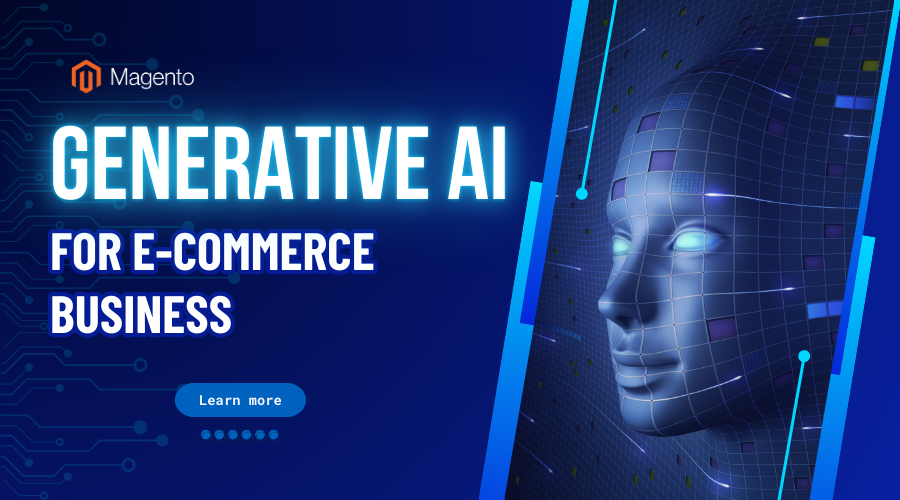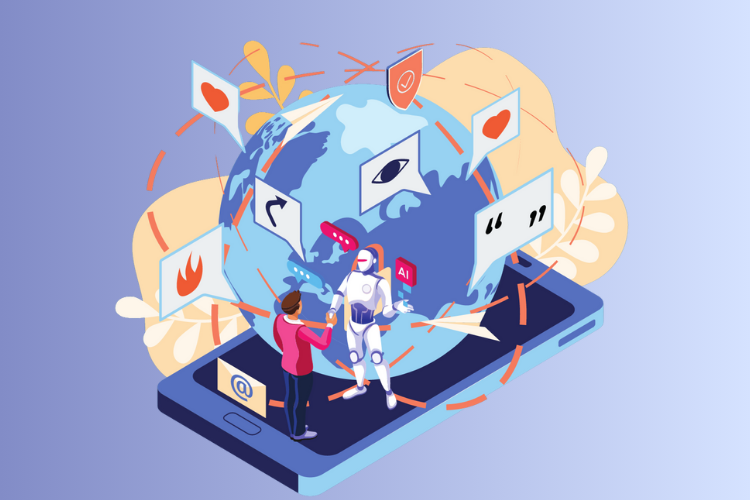
Generative artificial intelligence (AI) represents an exciting new frontier in technology with huge potential to transform businesses. As the name suggests, generative AI can generate brand-new content, designs, code and more from scratch using machine learning models. Rather than simply analyzing data, generative AI can create completely original outputs.
This emerging technology promises to automate repetitive tasks, enhance creativity, and discover valuable insights for organizations across sectors. However, realizing the full possibilities of generative AI requires thoughtful implementation to address current limitations.
This article explores the capabilities and applications of generative AI that business leaders should understand today to prepare for the technology’s rising impact tomorrow.
Table of Contents
I. Generative AI: Introduction and key notes

Generative AI refers to machine learning techniques like deep learning that allow systems to produce new content rather than simply classify, cluster or extract patterns from existing data sets. Prominent examples of generative AI include:
- Natural language processing: AI models can generate synthetic text that reads remarkably human-like. They are trained on vast datasets of text from books, online sources and more to learn the structure and organization of human language.
- Computer vision: AI image generators can create original images and artwork based on visual concepts. The models synthesize new examples by leveraging training datasets of images and art.
- Video/audio generation: Similar generative techniques can produce synthetic video footage, music and voices using neural networks. With AI text to video tools, users can turn simple written prompts into fully generated video content, bridging creativity and automation.
- 3D model generation: AI systems can also design 3D objects, furniture, mechanisms, architecture, and more based on 3D data libraries.
- Code generation: Instead of writing new software code from scratch, generative AI can automatically produce code for applications and websites with given parameters.
These diverse applications highlight the value of generative AI development services, which enable businesses and developers to leverage cutting-edge technology for innovative content creation. What makes generative AI so promising compared to previous AI is the combination of advanced machine learning techniques with almost endless data from the internet and digital sources to power the models.
II. Key business capabilities
Generative AI introduces new capabilities that promise to transform the business landscape in the coming years. Here are some of the most impactful areas:
1. Content creation
Today, generative AI can automatically create all forms of written content, such as articles, social media posts, webpage copy, emails, reports and more. The synthetic text flows naturally in human language. Brands can simply input topics and adjust length and parameters, and the AI will output unique, relevant content. Tools like Walter Writes AI not only generate content but also help humanize it to ensure it aligns with brand voice and passes AI detection checks.

Businesses can gain tremendous efficiency by relying on AI for initial content drafting. It alleviates writers from starting from blank pages while still maintaining final editing oversight. AI-generated text can inspire creative directions or be used outright, depending on quality needs. It may enable smaller teams to match the output of larger marketing groups.
As generative AI continues to evolve, its ability to mimic human tone, personality, and sophistication becomes increasingly refined—allowing brands to craft content that aligns closely with their identity. To further elevate the human quality of AI-generated content, many companies are turning to advanced post-editing tools like HumanizerPro AI Tool. This solution fine-tunes language, tone, and rhythm to ensure the final content reads naturally, emotionally resonates with readers, and maintains brand authenticity.
2. Data analysis and reporting
AI data analysis tools can scan datasets and corporate information to detect key patterns, insights and trends fully autonomously. This includes highlighting growth opportunities, emerging customer behaviors, changes in operational metrics, competitive forces and more.
The systems can take this analysis and automatically generate reports, presentations, visualizations and executive summaries to brief teams. This provides faster insights and frees up analyst time from manual reporting. Some solutions generate insights in conversational language, explaining discoveries in simple terms.
As data volumes grow exponentially, generative AI promises to uncover insights human teams could miss. It can connect dots across disparate sources while communicating findings directly in formats like PowerPoint decks.
3. Design and visual media
Leveraging billions of images, designs and artworks, AI systems can now generate original logos, graphic designs, product images, architectural sketches and more on demand. Creatives input requirements like themes, colors, shapes and layouts, and the generative models output numerous options to inspire or use directly.

The technology makes high-quality design accessible to the general public, small businesses and enterprises alike. Teams can rapidly iterate visual concepts, create mockups to test ideas and produce production-ready creative assets. AI can also generate product photos, scene illustrations, and data visualizations automatically from scratch.
As the systems grow more advanced, generative design AI may match or even enhance the creativity of human designers using data-driven approaches.
4. Personalization
Generative AI enables brands to customize and tailor content to every individual at scale. Natural language models can effortlessly rewrite webpage copy, emails, ads, and recommendations to each customer’s interests.
By generating product descriptions and landing pages for each user’s behavior and context, ecommerce sites can create a personalization that is unique to each user. AI can support chatbots to change responses to a customer’s sentiments, language and personality. Generative computer vision can power dynamic creatives that can further customize visuals to target audience.
Ultra-personalization provides more relevant experiences that mirror a human touch. This strengthens engagement and loyalty over time across digital touchpoints.
5. Automated workflows
AI systems can fully automate simple coding tasks, website changes, data entry, document generation and more. After initial training, generative models handle mundane workflows automatically rather than requiring manual effort.

For example, AI can update product databases, process data in business systems, file regulatory forms, synchronize changes across websites and even reply to common customer queries. This saves thousands of human working hours for repetitive digital tasks. It also minimizes human errors that often creep into manual work.
The benefits multiply across large enterprises as more workflows shift to generative AI. This frees up staff to focus on higher-judgment initiatives with greater impact, and it may also substantially reduce operational and labor costs over time.
III. Key use cases for your references
Generative AI introduces game-changing capabilities for enterprises across sectors today. Here we highlight some of the emerging high-impact use cases:
1. Marketing & Advertising

Revolutionizing marketing, automated content generation, personalized customer interactions and hyper-targeted promotions are just a few ways AI is changing marketing. Brands rely on generative systems to:
- Create blog posts, social captions, emails and ads at scale.
- Generate landing pages tailored to each campaign and audience.
- Design display ads with dynamic creative optimized for each user.
- Craft personalized recommendations and notifications to engage customers.
- Synthesize compelling marketing copy in seconds rather than days.
- Uncover insights across customer data to inform strategy.
The technologies enhance marketing agility, relevance and performance with data-driven automation.
2. Journalism & Publishing
Generative writing AI takes advantage of free reporter time and maximizes news production for media outlets. High-quality articles can be automatically generated from data sets, press releases, or story ideas.
Publishers see applications to:
- Produce first drafts of articles from statistics, reports and releases.
- Personalize news stories to each reader’s preferences.
- Adapt the tone and complexity of articles to target different audiences.
- Accelerate research and interviews with AI support.
- Scale coverage of niche topics using automated tools.
- Create interactive, data-driven explainer and analysis pieces.
The practices aid reporting velocity, free up resources, and provide more reader value.
3. Customer Support
Generative AI is transforming customer service through conversational agents and hyper-personalization. Brands are utilizing innovations like:

- AI chatbots provide 24/7 automated support via chat or voice.
- Natural language responses tailored to each customer’s tone and language.
- Automated resolutions for common support queries and requests.
- Chatbot hand-off to live agents when needed.
- Personalized recommendations and notifications to proactively help customers.
- Individualized web experiences based on user history and profile.
These intelligent applications provide faster, more contextual support across channels to strengthen loyalty.
5. IT & Software Engineering
Programming is being accelerated by AI tools that can generate code, debug issues and upgrade systems. IT teams employ solutions for:
- Code generation for websites, apps and scripts automatically.
- Turning natural language requests into software functions.
- Reviewing codebases to point out bugs, optimization possibilities and anti-patterns.
- Recommendation of code changes to add features to legacy systems.
- Without engineering resources, being able to complete simple data tasks and workflows.
- Surface urgent issues in real time by monitoring systems and traffic.
This amplifies productivity so developers can take on higher-level software projects.
The applications highlighted reveal only a fraction of generative AI’s expanding business potential today. Its versatility enables transformative use cases across nearly every function and vertical in the coming years.
IV. Generative AI for e-commerce: The common challenges

While promising, generative AI still faces crucial limitations for enterprises today. Business leaders should carefully consider the challenges around:
- Data Quality: The AI is only as good as its training data. If underlying data has biases, errors or lacks diversity, this propagates through models. Rigorously curating data and testing is vital.
- Content Integrity: Text or images created by AI lack accuracy and include content that may not be factual or harmful if governed properly. Manual processes are currently necessary for most application reviews.
- Job Displacement: Generative AI may be the next automation wave, but just like past automation waves, it could make some jobs redundant as machines start to create and analyze content. That’s why it makes sense to be proactive about assessing workforce impacts.
- Security: The security could be compromised by code, text or designs that systems generate to surface hidden flaws or generate new threats. Generative applications, especially software or cybersecurity, must be held with strict safeguards.
- Compliance & Ethics: With autonomous algorithms, this will become more difficult to achieve, and models will have to conform to regulations regarding bias, safety, privacy, and responsible AI. In some domains, you may need audits and external oversight.
- Trust & Transparency: If AI systems are too complex for stakeholders to understand or audit how they work, trust and adoption may be eroded. To realize business potential, model transparency and explainability are key to advancing.
With proactive, ethical addressing, these limitations will allow enterprises to reap good from generative AI and keep stakeholders safe.
Conclusion
The next wave of digital transformation for businesses is generative AI, which rides on top of prior analytics and automation tools. Using unsupervised machine learning, AI systems can generate intelligent content, insights, designs, code and more on their own, with no human rules.
The technology introduces step-change efficiencies in content production, data analysis, personalisation, workflows and customer service. Also, augmenting capabilities may also help in improving human creativity, strategy and decision-making. Generative AI’s potential is undeniable, but overcoming today’s limitations around quality, ethics and security remains crucial.












![[SALE OFF] Discount 30% All Premium Extensions On Christmas And New Year 2025 christmas-and-new-year-2025](https://landofcoder.b-cdn.net/wp-content/uploads/2024/12/christmas-and-new-year-2025-1-218x150.png)






